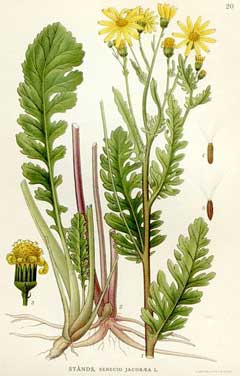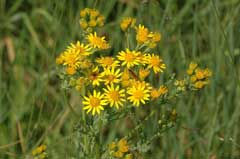 |
|
http://commons.wikimedia.org/wiki/File:Illustration_Senecio_jacobaea.jpg |
 |
| http://commons.wikimedia.org/wiki/User:Ghouston |
Translate this page:
Summary
Physical Characteristics

 Senecio jacobaea is a PERENNIAL growing to 1 m (3ft 3in) by 0.5 m (1ft 8in).
Senecio jacobaea is a PERENNIAL growing to 1 m (3ft 3in) by 0.5 m (1ft 8in).
See above for USDA hardiness. It is hardy to UK zone 5 and is not frost tender. It is in flower from June to October, and the seeds ripen from July to October. The species is hermaphrodite (has both male and female organs) and is pollinated by Bees, flies, Lepidoptera (Moths & Butterflies). The plant is self-fertile.
It is noted for attracting wildlife.
Suitable for: light (sandy), medium (loamy) and heavy (clay) soils and can grow in heavy clay and nutritionally poor soils. Suitable pH: mildly acid, neutral and basic (mildly alkaline) soils. It can grow in semi-shade (light woodland) or no shade. It prefers moist soil. The plant can tolerate maritime exposure.
UK Hardiness Map
US Hardiness Map
Synonyms
replaced synonym of: Jacobaea vulgaris
Plant Habitats
Meadow; Cultivated Beds;
Edible Uses
References More on Edible Uses
Medicinal Uses
Plants For A Future can not take any responsibility for any adverse effects from the use of plants. Always seek advice from a professional before using a plant medicinally.
Antirheumatic Astringent Diaphoretic Diuretic Emmenagogue Expectorant Homeopathy
The plant is astringent, diaphoretic, diuretic, emmenagogue and expectorant[9, 21]. The plant is harvested as it comes into flower and is dried for later use[9]. Use with caution[21], when applied internally it can cause severe damage to the liver[9]. See also the notes above on toxicity. An emollient poultice is made from the leaves[4]. The juice of the plant is cooling and astringent, it is used as a wash in burns, sores, cancerous ulcers and eye inflammations[4]. It makes a good gargle for ulcerated mouths and throats and is also said to take away the pain of a bee sting[4]. Caution is advised here since the plant is poisonous and some people develop a rash from merely touching this plant[K]. A decoction of the root is said to be good for treating internal bruises and wounds[4]. A homeopathic remedy is made from the plant[9]. It is used in the treatment of dysmenorrhoea and other female complaints, internal haemorrhages and other internal disorders[9].
References More on Medicinal Uses
The Bookshop: Edible Plant Books
Our Latest books on Perennial Plants For Food Forests and Permaculture Gardens in paperback or digital formats.

Edible Tropical Plants
Food Forest Plants for Hotter Conditions: 250+ Plants For Tropical Food Forests & Permaculture Gardens.
More

Edible Temperate Plants
Plants for Your Food Forest: 500 Plants for Temperate Food Forests & Permaculture Gardens.
More

More Books
PFAF have eight books available in paperback and digital formats. Browse the shop for more information.
Shop Now
Other Uses
Dye
A good green dye is obtained from the leaves, though it is not very permanent[4, 115]. A yellow dye is obtained from the flowers when alum is used as a mordant[4, 115, 168]. Brown and orange can also be obtained[168].
Special Uses
Attracts Wildlife
References More on Other Uses
Cultivation details
Succeeding on all but the poorest soils, this plant is a declared noxious weed in Britain spreading freely by seed. It should not be cultivated other than in controlled conditions for scientific research. Ragwort can be eradicated by pulling it up just before it comes into flower, or by cutting it down as the flowers begin to open (this latter may need to be repeated about six weeks later)[4]. Ragwort is a good food plant for the caterpillars of many butterfly and moth species, and is one of only two species that provide food for cinnabar moth caterpillars.
References Carbon Farming Information and Carbon Sequestration Information
Temperature Converter
Type a value in the Celsius field to convert the value to Fahrenheit:
Fahrenheit:
The PFAF Bookshop
Plants For A Future have a number of books available in paperback and digital form. Book titles include Edible Plants, Edible Perennials, Edible Trees,Edible Shrubs, Woodland Gardening, and Temperate Food Forest Plants. Our new book is Food Forest Plants For Hotter Conditions (Tropical and Sub-Tropical).
Shop Now
Plant Propagation
A noxious weed, it doesn't need any help in spreading itself about.
Other Names
If available other names are mentioned here
Native Range
TEMPERATE ASIA: Turkey, Russian Federation-Ciscaucasia (Ciscaucasia), Armenia, Azerbaijan, Georgia, Russian Federation-Western Siberia (Western Siberia), Russian Federation-Eastern Siberia (Eastern Siberia), Kazakhstan, Kyrgyzstan, Tajikistan, Uzbekistan, Mongolia, China (Xinjiang Uygur Zizhiqu) EUROPE: Denmark, United Kingdom, Ireland, Norway, Sweden, Austria, Belgium, Switzerland, Czech Republic, Germany, Hungary, Netherlands, Poland, Slovakia, Russian Federation (European part), Belarus, Estonia, Lithuania, Latvia, Moldova, Ukraine (incl. Krym), Albania, Bulgaria, Bosnia and Herzegovina, Greece, Croatia, Italy, Montenegro, Romania, Serbia, Slovenia, Spain, France, Portugal AFRICA: Morocco, Tunisia
Weed Potential
Right plant wrong place. We are currently updating this section.
Please note that a plant may be invasive in one area but may not in your area so it's worth checking.
Conservation Status
IUCN Red List of Threatened Plants Status :

Growth: S = slow M = medium F = fast. Soil: L = light (sandy) M = medium H = heavy (clay). pH: A = acid N = neutral B = basic (alkaline). Shade: F = full shade S = semi-shade N = no shade. Moisture: D = dry M = Moist We = wet Wa = water.
Now available:
Food Forest Plants for Mediterranean Conditions
350+ Perennial Plants For Mediterranean and Drier Food Forests and Permaculture Gardens.
[Paperback and eBook]
This is the third in Plants For A Future's series of plant guides for food forests tailored to
specific climate zones. Following volumes on temperate and tropical ecosystems, this book focuses
on species suited to Mediterranean conditions—regions with hot, dry summers and cool, wet winters,
often facing the added challenge of climate change.
Read More
Expert comment
Author
L.
Botanical References
17200
Links / References
For a list of references used on this page please go here
Readers comment